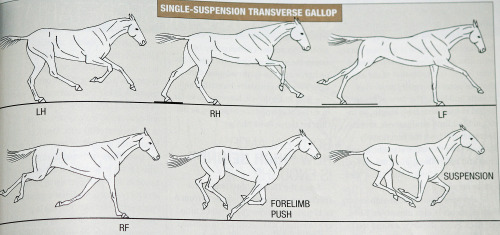me: *reads someone’s interpretation of a character*
me: they’re so wrong…..
me: [at dinner] they’re so wrong…
me: [trying to sleep] they’re so wrong….
me: [in the bathroom] they’re so wrong….
me: [breathing] the y RE So W rONg
Month: October 2015

And that ladies is why secrateriat is boss
Not only that, but Secretariat utilized something called a double-suspension transverse gallop that allowed him to carry sprint speed over distances of more than half a mile. In a normal, single-suspension transverse gallop there is only one moment where all four hooves leave the ground
in a double-suspension transverse gallop there are two
Secretariat had a stride longer than any other horse, but he also ran elastically, and was able to develop an extraordinary amount of downward-and-backward thrust, thus achieving double-suspension. He ran straighter and more efficiently than any other horse.
I’M SO INTRIGUED *gets pencil and paper*
Do you think his incredibly elastic gait contributed to his double-suspension gallop? What factors contribute to a horse preferring double-suspension over single-suspension? Is it a genetic behavior? Is it influenced by physical factors (IE Secretariat’s extraordinary gait)? Or is it purely a fluke when a horse uses the double-suspension gallop? What other horses did this? WHERE CAN I READ MORE????? *HEAVY BREATHING*
The elasticity refers to the flexibility of his back and loin conformation. The muscles of the pelvis, rib cage, and spine form a flexible and powerful spring that is the biomechanical root of speed. Secretariat had increased ability to coil the loin, and with it, increased elastic up-and-down flexibility of the back. The more flexible the back is, the longer the stride.
It is this long stride, and the incredibly powerful downward-and-backward thrust of his hind legs that allowed him to have a double-suspension transverse gallop. I don’t know of any other horses that have achieved double suspension, but it has been speculated that if we had more footage of Man O’ War we would see that he ran at a double-suspension transverse gallop as well.
The head of our university equine department said he watched Secretariat run in person. Years later as a professor of equine functional anatomy, he described Secretariat with awe and reverence:
“Secretariat was a freak of nature! There’s never been a horse like him, and there’ll never be another.”Reblogging for young!Toasty, who was heavily into the horse fandom. This is deeply cool, and something I wish series like The Black Stallion had been able to explain… The novels and the non-fiction accounts I read made it seem like some horses were basically magic, or just succeeded because they tried harder (“this horse has such a big heart,” “he just won’t quit,” etc.). Proto!Scientist!Toasty spent a bunch of time puzzling over what made Secretariat and Man O’ War so stunningly fast.
A family is a risky venture, because the greater the love, the greater the loss… That’s the trade-off. But I’ll take it all.
The reason the Latin Mass seems to be ‘more reverent’ is not because the language is in Latin or because the priest obeys all the rubrics or because he faces East. (remember I am not against all those things!) The reason the Latin Mass seems more reverent is because the people who attend the Latin Mass are far more likely to be well catechized Catholics who believe in the old, old story of God’s supernatural grace in the world, the tender story of a pure maid who bore the Son of God into the world to suffer and die and save poor lost sinners. Those who prefer the Latin Mass are more likely to believe and seek to live these precious old truths, and that’s why the Latin Mass seems more reverent.
The reason the Novus Ordo so often seems irreverent is not any intrinsic deficit in the Novus Ordo. (otherwise why would Holy Church say that it remains the Ordinary Form of the Mass?) Instead the Novus Ordo is sometimes celebrated irreverently because people regard the Mass as a celebration of their social activism, or a community festival to increase their self esteem or a sentimental, individualistic, spiritual comfort session. They have ceased to really believe in sin and grace and a God who saves, and instead they look to one another for their salvation. So there’s not much reverence required there.
cooper: what would you do to help elizabeth keen?
tom: anything
tom: sell her out for money to international criminals
tom: entrap her in a fake relationship
tom: lie to her for years
tom: manipulate her
tom: emotionally abuse her
tom: use her to make myself feel better
tom: put her name on a kill list then hand it over no problem
tom: get her friend/coworker killed
tom: kidnap her at gunpoint
tom: use her as a human shield
tom: murder an innocent person and blame it on her then walk away
tom: punch her in the head
tom: kick her in the stomach
tom: yell at her
tom: you name it
tom: i really love her, man
tom: so anything
cooper: …
cooper: …
cooper: i think i want my fake brain tumor back
cooper: it induced less nausea & vomiting than this fake redemption story
Paris WW2/Modern Day
After collecting vintage photographs of the Nazi occupation of Paris, french artist Julien Knez decided to visit the locations that were captured in the historic images. The next two months Knez spent around Paris recreating the famous photos from WW2 in front of their modern day counterparts.
Me: *sees character that I love*
Me: Oh man I can’t wait to see them freaking break down I want to see them crying and fighting this is something I want to witness
Character: *actually breaks down hopelessly in canon*
Me: NO WAIT NOT LIKE THIS THIS ISN’T WHAT I ASKED FOR OH GOD I DIDN’T MEAN IT I’M SORRY I TAKE IT BACK I TAKE IT BACK I

history meme | one out of nines kings and queens
↳ King Jadwiga of Poland (reigning October 16 1384 – July 17 1399)
King Jadwiga of Poland, also known as King Hedwig, was the first female ruler of The Kingdom of Poland. With her ancestry connecting back to the native Piast dynasty of Poland, she is said to be the most Polish of all of Poland’s rulers. After her father’s death and much dispute over who was to be the next ruler of Poland, at roughly age eleven Jadwiga was crowned King of Poland as Polish law did not specify whether a King could be male or female – although this title is thought to have been given to her to distinguish the fact that she was not a queen consort but rather a queen regent.
Due to the fact that Jadwiga was a minor during the first years of her reign, she was merely a tool for her advisers to exploit. Jadwiga, however, matured quickly (particularly her charm and kindness) and strengthened her position and soon became a ruler in her own right. A notable part of her early rule includes her marching at the head of Polish troops to Ruthenia where all but one governors submitted her without opposition after a group of rebels murdered her mother. During the last years of her reign, Jadwiga’s strength as a leader continued to show as she was a skilled mediator – famed for her intelligence and impartiality. She strived to create peace between her country and the threats to it.
Jadwiga attended many charities and cultural festivals as ruler. She sponsored writers and artists and donated much of her personal wealth, including her royal insignia, to charity, for purposes including the founding of hospitals. She financed a scholarship for twenty Lithuanians to study at Charles University in Prague to help strengthen Christianity in their country, to which purpose she also founded a bishopric in Vilnius. Among her most notable cultural legacies was the restoration of the Kraków Academy.
Jadwiga gave birth to a daughter, Elizabeth Bonifacia, on June 23 1399. Elizabeth died on July 13 1399. Jadwiga passed away soon after on July 17 1399. She was buried with her daughter in Wawel Cathedral on August 24 1399.
Jadwiga often prayed before a large black crucifix hanging in the north aisle of Wawel Cathedral. During one of these prayers, the Christ on the cross is said to have spoken to her. The crucifix, “Saint Jadwiga’s cross,” is still there, with her relics beneath it. Because of this event, she is considered a medieval mystic. According to another legend, Jadwiga took a piece of jewelry from her foot and gave it to a poor stonemason who had begged for her help. When the king left, he noticed her footprint in the plaster floor of his workplace, even though the plaster had already hardened before her visit. The supposed footprint, known as “Jadwiga’s foot”, can still be seen in one of Kraków’s churches. On June 8 1997, Jadwiga was canonized as a saint by Pope John Paul II. [x]



























